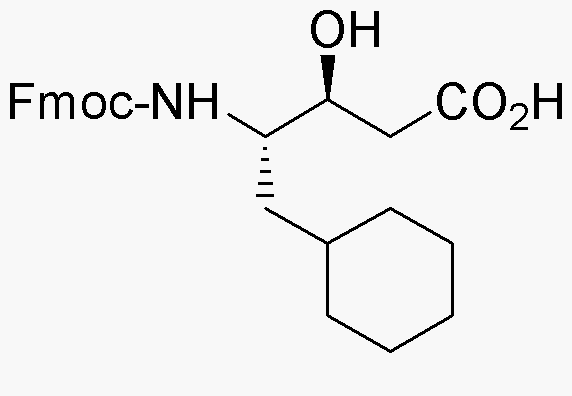Fmoc-(3S,4S)-4-amino-3-hydroxy-5-cyclohexylpentanoic acid is widely utilized in research focused on:
- Peptide Synthesis: This compound serves as a key building block in the synthesis of peptides, particularly in solid-phase peptide synthesis, where its protective Fmoc group allows for selective deprotection and coupling.
- Drug Development: Researchers leverage its unique structural properties to design and develop new pharmaceuticals, especially in the field of neuroactive compounds, enhancing the efficacy and specificity of drug candidates.
- Bioconjugation: It is used in bioconjugation processes to attach peptides to various biomolecules, facilitating the creation of targeted therapies and diagnostic agents in biotechnology.
- Material Science: The compound finds applications in the development of novel materials, particularly in creating hydrogels that mimic biological environments for tissue engineering applications.
- Research on Amino Acid Analogues: It is valuable in studying amino acid analogues, helping researchers understand the structure-activity relationships that influence biological functions and interactions.
General Information
Properties
Safety and Regulations
Applications
Fmoc-(3S,4S)-4-amino-3-hydroxy-5-cyclohexylpentanoic acid is widely utilized in research focused on:
- Peptide Synthesis: This compound serves as a key building block in the synthesis of peptides, particularly in solid-phase peptide synthesis, where its protective Fmoc group allows for selective deprotection and coupling.
- Drug Development: Researchers leverage its unique structural properties to design and develop new pharmaceuticals, especially in the field of neuroactive compounds, enhancing the efficacy and specificity of drug candidates.
- Bioconjugation: It is used in bioconjugation processes to attach peptides to various biomolecules, facilitating the creation of targeted therapies and diagnostic agents in biotechnology.
- Material Science: The compound finds applications in the development of novel materials, particularly in creating hydrogels that mimic biological environments for tissue engineering applications.
- Research on Amino Acid Analogues: It is valuable in studying amino acid analogues, helping researchers understand the structure-activity relationships that influence biological functions and interactions.
Documents
Safety Data Sheets (SDS)
The SDS provides comprehensive safety information on handling, storage, and disposal of the product.
Product Specification (PS)
The PS provides a comprehensive breakdown of the product’s properties, including chemical composition, physical state, purity, and storage requirements. It also details acceptable quality ranges and the product's intended applications.
Certificates of Analysis (COA)
Search for Certificates of Analysis (COA) by entering the products Lot Number. Lot and Batch Numbers can be found on a product’s label following the words ‘Lot’ or ‘Batch’.
Número de catálogo
Número de lote/lote
Certificates Of Origin (COO)
This COO confirms the country where the product was manufactured, and also details the materials and components used in it and whether it is derived from natural, synthetic, or other specific sources. This certificate may be required for customs, trade, and regulatory compliance.
Número de catálogo
Número de lote/lote
Safety Data Sheets (SDS)
The SDS provides comprehensive safety information on handling, storage, and disposal of the product.
DownloadProduct Specification (PS)
The PS provides a comprehensive breakdown of the product’s properties, including chemical composition, physical state, purity, and storage requirements. It also details acceptable quality ranges and the product's intended applications.
DownloadCertificates of Analysis (COA)
Search for Certificates of Analysis (COA) by entering the products Lot Number. Lot and Batch Numbers can be found on a product’s label following the words ‘Lot’ or ‘Batch’.
Número de catálogo
Número de lote/lote
Certificates Of Origin (COO)
This COO confirms the country where the product was manufactured, and also details the materials and components used in it and whether it is derived from natural, synthetic, or other specific sources. This certificate may be required for customs, trade, and regulatory compliance.


